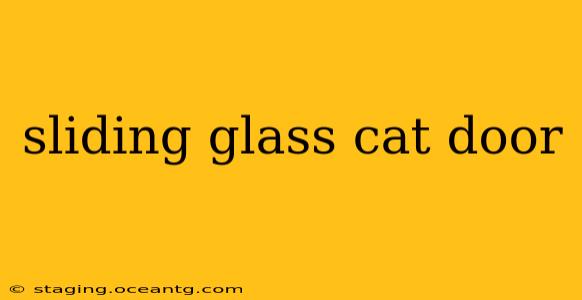Many cat owners dream of providing their furry friends with the freedom to come and go as they please, while maintaining home security. A sliding glass cat door offers a convenient and often aesthetically pleasing solution. But choosing the right one can feel overwhelming. This comprehensive guide will walk you through everything you need to know about sliding glass cat doors, from installation to maintenance, answering all your burning questions.
What are the Different Types of Sliding Glass Cat Doors?
There are several types of cat doors designed for sliding glass doors, each with its own pros and cons. The main differences lie in the installation method and the level of security they offer.
-
End Panel Cat Doors: These are installed in the existing frame of your sliding glass door, usually in one of the end panels. This method is generally less invasive than others, requiring fewer modifications to the door itself. However, it may limit the size of the cat door you can install.
-
Insert Cat Doors: These are designed to replace a section of your sliding glass door. This allows for larger openings and greater flexibility in placement. However, this is a more involved installation process and may require more advanced DIY skills.
-
Wall-Mounted Cat Doors: If you don't want to modify your sliding glass door at all, a wall-mounted cat door adjacent to the sliding door is a viable alternative.
Choosing the right type depends on your DIY skills, the existing structure of your sliding glass door, and your budget.
How Much Does a Sliding Glass Cat Door Cost?
The cost of a sliding glass cat door varies greatly depending on the type, size, material, and brand. Simple, end-panel cat doors might cost between $20 and $50, while more complex insert models can range from $50 to well over $100. Always factor in the cost of installation, which can range from DIY (free) to professional installation (potentially costing several hundred dollars depending on location and complexity).
How Difficult is it to Install a Sliding Glass Cat Door?
The difficulty of installation varies widely depending on the chosen type of cat door. End-panel cat doors are generally considered easier to install, often requiring only simple tools and a basic understanding of DIY. Insert cat doors, however, require more precise measurements, cutting, and potentially some specialized tools. If you lack confidence in your DIY abilities, it's always best to hire a professional installer.
Can I Install a Sliding Glass Cat Door Myself?
Yes, many homeowners successfully install sliding glass cat doors themselves. However, it's crucial to carefully follow the manufacturer's instructions. Accurate measurements are paramount, especially for insert-type doors. If you're unsure about any part of the process, consult with a professional or watch tutorial videos before starting. Remember, improperly installed cat doors can compromise the security and energy efficiency of your home.
What are the Security Concerns with Sliding Glass Cat Doors?
Security is a legitimate concern with any cat door. Choose a high-quality model with features like a locking mechanism to deter unwanted intruders. Also, consider the location of the door; avoid installing it in easily accessible areas. Some models offer additional security features such as magnetic locks or multi-point locking systems.
How Do I Choose the Right Size Cat Door for My Cat?
Measure your cat's height and width at their widest points. Add a couple of inches to allow for comfortable passage. Ensure the chosen cat door size is compatible with the frame of your sliding glass door. Consult the manufacturer’s specifications before purchasing to ensure the proper fit.
What Materials are Sliding Glass Cat Doors Made From?
Sliding glass cat doors are commonly made from durable materials like plastic, aluminum, or a combination of both. Plastic offers affordability and ease of installation, while aluminum tends to be more robust and weather-resistant.
How Do I Maintain a Sliding Glass Cat Door?
Regular maintenance is key to prolonging the lifespan of your cat door. Periodically clean it to remove dirt and debris. Check for any damage or wear and tear, and address any issues promptly. Lubricate moving parts as needed to ensure smooth operation.
This guide provides a comprehensive overview of sliding glass cat doors. Remember that choosing and installing the right one requires careful planning and consideration of your specific needs and circumstances. Happy installing!
